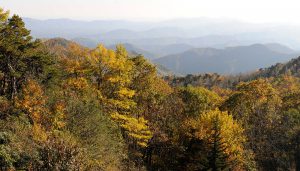Little of the ancient Appalachian forest remains due to intensive mining and agriculture during the 19th and 20th centuries. But in the pockets that have survived up to twenty different tree species occur at the canopy level. These are the so-called Appalachian mixed mesophytic forests, described by the well-known forest ecologist Emma Braun. Mixed among the oaks, maples, ash, elms and linden trees, are genera that do not naturally occur in Europe, such as Liriodendron, Gleditsia and Robinia. We are familiar with both deciduous and evergreen magnolias, and consider them ornamental shrubs, but the American Cucumber magnolia grows the size of an adult forest tree. This also applies to the Black cherry, first introduced in Western European forests as a soil improver and nowadays fought as an invasive forest pest. American tree enthusiasts regard our beautiful American chestnut specimens (Castanea dentata) with envy and hushed admiration, a formerly prominent species of the Appalachian forests that has been close to extinction due to a terrible blight caused by a type of fungus. A number of coniferous species are found at higher altitudes in these mountains. The rare Carolina hemlock, which replaces the Canadian hemlock, stands at the top of arboretum Group 15, between the Red spruce and the Fraser fir.


